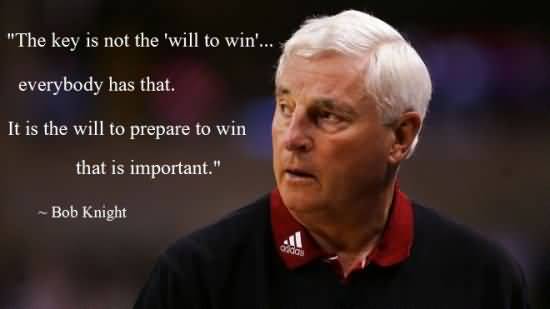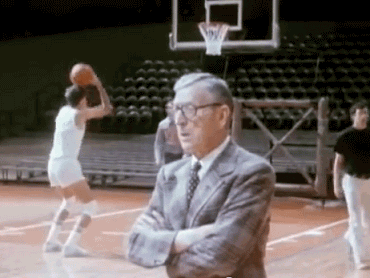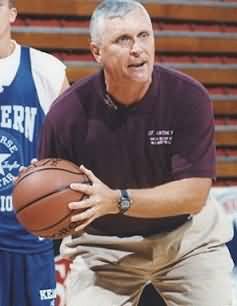How to Plan Good Basketball Practices
By Dr. James Gels, From the Coach’s Clipboard Basketball Playbook"Helping coaches coach better..."
Disclosure: This page contains affiliate links, which means that Coach's Clipboard receives a small commission (at no cost to you) if you make a purchase using these links.
"The structure of your practice is the most determining reason for your success or lack of success as a coach." - Bob Knight

I have been asked by coaches to show a sample practice plan, so I have included three below... (1) first practice of the season, (2) a mid-season practice, and (3) a tournament-time practice.
Now these are just examples. We will vary the drills and skills, and the team skills from practice to practice. Certain skills should be practiced every practice, such as the ball-handling, dribbling, and shooting drills. Depending on your schedule, the amount of practice time you have and what your specific team needs are, you vary your drills.
A rough rule of thumb for high school teams is to spend about half the time on individual fundamentals and half the time on team skills. If you are working with younger kids, you would slant this more toward fundamental skills.
When teaching a new offense, defense, plays, press offense, press defense, and other team skills, select your drills and teach by progression. See "How to Teach Basketball by Progression".

Coach John Wooden
You must plan each practice. John Wooden has said he and his assistants often would spend more time planning a practice than the actual practice itself lasted. Keep a loose-leaf notebook of each of your practices that you can refer back to. After each drill or after practice, you can scribble additional notes on your practice plan from that day... things that you have learned, or things that you feel need special emphasis.
Don't come to the gym each day without a plan and think you can just "wing it". You have to plan for success and plan your practices just like a teacher creates a lesson plan for his/her English or math class. Your practice should be like a classroom and you are the teacher.
Practice Pointers:
Stretching exercises
Stretching is done at the start of practice in order to avoid injuries (although some recent studies have shown that stretching really may have little value in reducing injuries). I always dislike wasting precious gym time on stretching exercises. So players are asked to come 10-15 minutes early and do their stretching on the sidelines, so we are ready to go once practice starts.This might not be practical, and you may need to do 10 minutes of stretching at the beginning. While the team is stretching, you can discuss your plans for the day, what things need to be worked on. Or use the time to praise good things that have happened, or reflect on your "quote of the day" (see below), etc.
Selecting drills
Select drills that help teach individual and team fundamental skils, as well as teaching what you are trying to accomplish, or trying to correct. Use the guidelines below.Select your drills from the "Selecting and Using Drills" page, which gives a brief description of each drill and about how much time to allow. You might have a core of selected drills that you use all the time. You can throw in other drills from time-to-time to teach a specific skill, or just to avoid boredom and spice things up a bit.
Move quickly from one drill to another
Don't spend half of your practice time on one drill. The kids will get bored and won't learn much after the first 5-10 minutes into the drill. If they mess up, they will get another chance to run that drill tomorrow.Make drills competitive
Whether you are doing 1-on-1 or 5-on-5 drills, shooting drills, etc., make them competitive with a winner and loser. We have losers do 5-10 push-ups. In free-throw shooting drills, we will often have missed shots followed by running a lap, as this simulates the running and fatigue in game situations.Budget your time for each drill
If you are introducing a new drill, play, offense, defense, etc, you will have to allow more time the first time. If you are reviewing something, like a set of plays or your out-of-bounds plays (that they should already know), move quickly through these. You are just reinforcing their memory (a brief repetitive exercise that can be done each day).Follow an up tempo exhausting drill with 5 minutes of something less aerobic
Make them work hard, but don't be unreasonable.Free-Throw Shooting
Do your free-throw shooting after an aerobic, running drill when the players are tired, in order to simulate the leg and body fatigue that occurs in the real game setting.Have every player do dribbling and ball-handling drills
Why have post players waste their time doing guard-type dribbling drills? It's because doing these drills will make your post players better athletes in general, will help their coordination, and will improve their "hands". Also, for youth players, how do you know a player remain a post player all his/her life?Break-down post/perimeter drills
If you have a good assistant, you can plan some time for individual skills with perimeter players on one end of the floor, and your post players on the other end. See: Post Player Breakdown Drills, Guard Breakdown Shooting Drills, and Motion Offense Drills.Do not show favoritism
All players must work hard. Instill in your best players that they must lead by example, and to be a great leader, must be willing to work harder than anyone else. Don't ignore your "role players" (a better term than "subs", or "bench players")... make them feel they are contributing and encourage them.Conditioning drills
Early in the season, we run a lot of conditioning drills. I believe your players and team will improve much more by doing conditioning drills than a lot of push-ups and running without the ball.If you are going to make your players run, make them do it with a ball... like full-court speed dribbling, using the right hand one direction and the left hand coming back. Rather than running a "gut buster" do a fast-paced aerobic drill like speed dribbling. The kids will get just as tired, will hate it just as much, but their dribbling and conditioning will both improve.

Coach Bob Hurley
Tournament time
Getting into tournament play, or a crucial game, you might spend most of your time on team skills preparing for the big game, working on any special situations necessary to play the upcoming opponent.For example, you might want to refine your press break, or your full-court press, or how you will defend a certain star player, or how you will attack their zone defense, etc.
Later in the season during tournament time, we will often reduce our practices from 120 minutes to 90 minutes or less and focus on team skills and the upcoming game. It has been said that more tournament games are lost by over-practicing than under-practicing. Players can get burned-out by the end of the season. We want our tournament run to be fun... mostly looking forward to playing games, with short practices in-between.
Open or closed practices
Whether to allow parents, spectators in the gym during practice is up to you and your philosophy. But make sure you have rules established from the start of the season.If you allow parents in the gym, make sure they understand that it is a classroom and they must keep quiet and not coach from the stands. In this becomes a problem, reserve the right to close your practices at any time.
End practice on an upbeat, positive note
We like to end practices with something fun that builds team spirit. With our varsity and JV teams, we have each player shoot a shot from half-court. If no-one makes it, everybody runs. If just one player makes the half-court shot, NOBODY runs!So when a player makes the shot, usually the team celebrates with a lot of high-fives and hugs, since they don't have to run. In our first practice of the year, we will tell our players to get emotional and celebrate when someone makes that shot.
Sometimes, when we feel we've had a really good, hard practice but no-one makes the shot, coach will have one of the assistants or a manager try a 3-point shot or a free-throw to save the day.
Sometimes we will tell them that they don't have to run if John (the smallest player on the team) can dunk the ball in 10 seconds... they quickly realize that they must grab John, hoist him up to the rim, so John can dunk it. All these little things help build team spirit.
NOTE: Also see Coach Ken Sartini’s practice planning form.
Below are three sample practice plans for a high school varsity team...
(1) First practice of the season(2) Mid-season practice
(3) Tournament-time practice
Sample Practice Plan - First practice of the season
We are a running team... fast-breaking, full-court pressing team, so conditioning is very important. Our first week of practice is very grueling and tough with a lot of conditioning drills and running... a full 2-hour practice. We start laying the foundations of our man-to-man defense and our full-court press. After the first week, we will start adding a few plays including out-of-bounds plays.2:45-3:00 Pre-practice stretching, warm-up
3:00-3:10 Practice starts... full-court dribble moves
3:10-3:30 Fast break drills2-on-1 competitive drill
4-on-4-on-4 - no press
4-on-4-on-4 - press to half-court
3:30-3:35 Free throws - shoot 10.
3:35-4:15 Half-court man-to-man defense2-on-2 deny and help
2-on-2 stop seam (help and recover)
3-on-3 stop seam and help
4-on-4 shell - positioning
4-on-4 shell - vs dribble-penetration
4-on-4 shell - vs pass and cut
5-on-5 ball on the wing
5-on-5 live - full switch
4:15-4:25 Run sprints and free-throws.
4:25-4:50 Match-up press drills2-on-2 double and chase (back-tip)
2-on-2 cut and double
2-on-2 run and jump
3-on-3
4-on-4
5-on-5 vs 2-up
4:50-4:55 Run and shoot free throws
4:55-5:00 left-hand, full-court lay-ups
5:00 Dismiss
Sample Mid-Season Practice Plan
We always run some of our full-court drills, both offense and defense, but also work on reviewing and adding plays, and running our half-court offense and defense. Not in this practice plan, we may add or review out-of-bounds plays. We often breakdown for 10-15 minutes with perimeter and post player drills on each end. We will also work on how we handle various screens.2:45-3:00 Pre-practice stretching, warm-up
3:00-3:05 Practice starts... Rayder shooting drill
3:05-3:20 Fast break drills5-on-5 full-court vs man-to-man (run motion offense)
5-on-5 full-court vs man-to-man (run set plays)
5-on-5 full-court vs 2-3 zone (run zone offense and zone plays)
3:20-3:25 Free throws
3:25-3:40 Breakdown for post and perimeter drills
3:40-4:05 80 Full-court press-offense4:05-4:10 Free throws
4:10-4:30 Half-court man-to-man defense4-on-4-on-4 shell - 3 defensive stops
5-on-5 shell - vs baseline dribble-penetration
5-on-5 vs next opponent
61 vs 2-up
61 vs 2-up with inbounder cutting through
Defending opponent's half-court sideline play
4:50-4:55 Free throws
4:55-5:00 left-hand, full-court lay-ups
5:00 Dismiss
Sample Tournament-time Practice Plan
Here it depends on how many practices you have before your next game. If we have three practices, the first will be like any regular season practice. If we only have two practices, the first will be moderately strenuous for about 90 minutes. The second will last usually less than 90 minutes and will be less strenuous, with more focus on the opponent, special plays and situations, etc. We still want to "get up a sweat", but not as much, and do a fair amount of shooting.2:45-3:00 Watch game film.
3:00-3:05 Practice starts... Rayder shooting drill
3:05-3:25 Fast break drills5-on-0, 5-trips drill - run m2m plays
5-on-0, 5-trips drill - run zone plays
4-on-4-on-4 drill
3:25-3:30 Free throws
3:30-3:40 Half-court man-to-man defense vs opponent's offense3:40-3:45 3-2-1 Shooting drill
3:45-3:55 Match-up press vs opponent's press-breaker
3:55-4:00 Free throws
4:00-4:15 Special plays and situations... "Hail Mary", inbound plays, 4-corners delay offense
4:15-4:20 45-Shooting drill
4:20 Dismiss
Also see:
- Important Points to Consider When Planning a Basketball Practice - Creating a Master Plan
- Competition in Drills, Your Greatest Tool to Improve Execution

Practice Planner Live
Use this online program and get access to the tools professionals use. Plan practices easily, quickly and more effectively. Have all your drills and thoughts in one place. Get access to your practice stats and see if your team play reflects what you are working on... See statistics of your practice. Are you focusing too much time on one aspect of the game? Now you never have to guess! Baseball, Basketball, Football, Soccer, and More! Get the Practice Planning Edge Today!
After completing your purchase, you will be contacted by Practice Planner Live (usually within 24 hours) regarding setting up your account, access, etc.